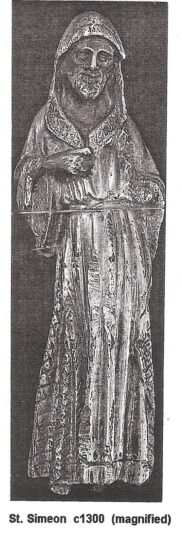Rare Find Near Buntingford
Rosemary Bennett
In 1999 a small silver-gilt figure, measuring less than two inches (4.4 cms) in height was unearthed, by a metal detectorist, near Buntingford. It was declared treasure trove and subsequently purchased by the British Museum for £50,000 with a grant of £20,000 from the National Art Collections Fund (NACF). The acquisition is described by the James Robinson, Keeper of the British Museum’s Department of Medieval and Modern Europe, in the NACF’s ‘2000 REVIEW’. He has very kindly given me permission to extract details from his article to report on this exciting local find for the benefit of HWLHS members. A more precise location for the find is known but as this rare find attracted national prominence at the time, a vague location was given to protect the owner of the land.
Dating to approximately 1300 the little figure illustrated here is of exceptional quality and a very rare survival of the period. It is thought to have been made either in France or Flanders and to have come from a reliquary, shrine, crosier or book. The face is very detailed and the figure’s demeanour and posture suggests it represents an Old Testament prophet or priest. Unfortunately the iconographic symbol, which would have been held in his left hand, is missing for it would have enabled experts to identify which saint the figure represents. However it is thought, for various reasons, to be Simeon, the officiating priest at the Presentation of Christ in the Temple.
The religious upheaval of the Reformation and Civil War periods led to mass destruction of religious items. Objects were smashed and priceless metal work melted down for reuse and relatively few items remain to show the wealth and quality of workmanship that existed all those centuries ago. As it was thought that a place in heaven could be bought the church acquired incredible wealth. Poor people bought fake ‘relics’ from pardoners for much the same reason.
.There is no way of deducing this figure’s source. Its origin may not have been anywhere near Buntingford as it may have become lost in transit to be melted down. A very long shot could be the possibility that it became lost when Rowney Priory, Great Munden near Buntingford, was robbed in the 15th century. It is pure speculation.
Rowney Priory, dedicated to St. John the Baptist, was home to Benedictine nuns. It was founded in 1164 by Conan, Duke of Brittany and Earl of Richmond and the Lords of the Manor of Great Munden were among its patrons. The Priory was reputed to have been quite wealthy in its earlier days but by the early 14th century was probably known for the improper behaviour of its members. For in 1375 the Manor Court Rolls record the Prioress to have been guilty of a hand-to hand scuffle with the chaplain, when blood was drawn and later, in 1401, a Joan Ardilesley was arrested for wearing secular dress.
Robbers plundered the Priory of its treasures in 1408 and this left nuns without the means of holding divine offices and the Bishop of Ely offered an indulgence to those able to help them. By 1430 the Priory lacked the funds needed to carry out essential repairs to its buildings and the prioress appealed to the Chancellor for permission for a proctor to go around the countryside collecting alms on their behalf ”as they could not live on their own resources”.
Their request was granted. In 1448 the nuns appealed to the King for permission to appoint John Trevelyan, an old Franciscan monk, as chaplain as they could not afford a younger man which would be unseemly anyway.
Matters did not improve long term and in 1457 the Priory was voluntarily dissolved. The Prioress, Agnes Selby, made over the building with all its fittings to John Ffray, Chief Baron of the Exchequer and owner of the Manor of Great Munden. Many smaller priories were voluntarily dissolved during the late 15th century, long before Henry VIII broke away from the power of Rome.
References
2000 Review, National Art Collections Fund
Victoria County Histories, Hertfordshire, Volume IV



Add your comment about this page